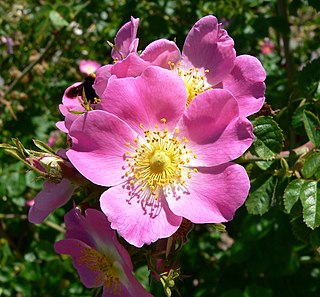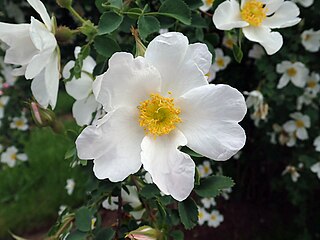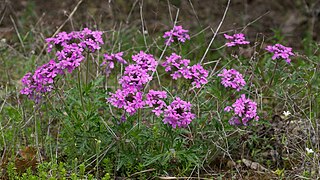
A rose is either a woody perennial flowering plant of the genus Rosa, in the family Rosaceae, or the flower it bears. There are over three hundred species and tens of thousands of cultivars. They form a group of plants that can be erect shrubs, climbing, or trailing, with stems that are often armed with sharp prickles. Their flowers vary in size and shape and are usually large and showy, in colours ranging from white through yellows and reds. Most species are native to Asia, with smaller numbers native to Europe, North America, and Northwest Africa. Species, cultivars and hybrids are all widely grown for their beauty and often are fragrant. Roses have acquired cultural significance in many societies. Rose plants range in size from compact, miniature roses to climbers that can reach seven meters in height. Different species hybridize easily, and this has been used in the development of the wide range of garden roses.

Rosa laevigata, the Cherokee rose, is a white, fragrant rose native to southern China, Taiwan and Vietnam. It is an invasive species in countries including Australia, Japan and the United States.

Dryas is a genus of perennial cushion-forming evergreen dwarf shrubs in the family Rosaceae, native to the arctic and alpine regions of Europe, Asia and North America. The genus is named after the dryads, the tree nymphs of ancient Greek mythology. The classification of Dryas within the Rosaceae has been unclear. The genus was formerly placed in the subfamily Rosoideae, but is now placed in subfamily Dryadoideae.

Amomum is a genus of plants containing about 111 species native to China, the Indian subcontinent, Southeast Asia, New Guinea, and Queensland. It includes several species of cardamom. Plants of this genus are remarkable for their pungency and aromatic properties.

Pachycereus is a genus of large cacti native to Central America and Mexico. They form large shrubs or small trees up to 15 m tall, with stout stems up to 1 m in diameter. Pachycereus comes from the ancient Greek παχύς (pachys) meaning "thick" and the Latin cereus meaning "torch".
Echinomastus was a formerly recognized genus of cacti. As of February 2024, it is accepted as a synonym of Sclerocactus. Species formerly placed in the genus are native to the southwestern United States and Mexico.

Selenicereus, sometimes known as moonlight cactus, is a genus of epiphytic, lithophytic, and terrestrial cacti, found in Mexico, Central America, the Caribbean and northern South America. The term night-blooming cereus is also sometimes used, but this is also used for many night-blooming cacti, including Epiphyllum and Peniocereus. In 2017, the genus Hylocereus was brought into synonymy with Selenicereus. A number of species of Selenicereus produce fruit that is eaten. The fruit, known as pitaya or pitahaya in Spanish or as dragon fruit, may be collected from the wild or the plants may be cultivated.

Eudianthe coeli-rosa, called the rose of heaven, is a flowering plant in the family Caryophyllaceae, native to the Canary Islands, Morocco, Algeria, Tunisia, Libya, Portugal, Spain, France, and Italy. An annual, it is grown in gardens as an ornamental.

Rosa moyesii is a species of flowering plant in the rose family Rosaceae. It is native to western China. Growing to 4 m (13 ft) tall by 3 m (10 ft) wide, it is a vigorous deciduous shrub, with plentiful matte green leaves and flat red or pink flowers, with yellow central stamens, in summer. These are followed in autumn by prominent bottle-shaped rose-hips.

François Crépin was an important botanist of the 19th century and director of the National Botanic Garden of Belgium.

Anthyllis vulneraria, the common kidneyvetch, kidney vetch or woundwort is a medicinal plant native to Europe. The name vulneraria means "wound healer".

Rosa fedtschenkoana is a species in the plant genus Rosa in the family Rosaceae. Some authorities consider it a synonym of Rosa webbiana. It is native to the foothills of the Ala Tau, Tian Shan and Pamir-Alai mountain ranges in central Asia and northwest China. It is named after Olga Fédchenko, a Russian botanist. It is deciduous, forming a bushy and suckering shrub up to 2.5 metres high and as much across. The branches are covered in many prickles, many of which are fine and straight, but some are thicker and slightly hooked. The pinnate leaves are pale greyish green in colour and have usually between 7 and 9 leaflets. The flowers are white, up to 5 cm across, and are borne singly or in small clusters at the tips of the branches throughout the summer months. The flowers' scent has been described as being "like 'Hovis' [brown] bread with a little blackberry jam". The flowers are followed by small, pear-shaped, bristly orange-red fruits.

Cassia javanica, also known as Java cassia, pink shower, apple blossom tree and rainbow shower tree, is a species of tree in the family Fabaceae. Its origin is in Southeast Asia, but it has been extensively grown in tropical areas worldwide as a garden tree owing to its beautiful crimson and pink flower bunches.

Rosa lucieae, the memorial rose, is a species of rose native to eastern Asia.

Rosa arabica is a species of rose in the plant family of the Rosaceae, endemic to the Mount Catherine region in the south of the Sinai in Egypt. The species is considered critically endangered.

Verbena canadensis, commonly known as rose mock vervain, rose verbena, clump verbena or rose vervain is a perennial herbaceous flowering plant in the verbena family (Verbenaceae) with showy pink to purple flowers.. It is native to the eastern and south-central areas of the United States. This species is widely cultivated as an ornamental, and naturalized populations have been established outside its native range, such as in the northeastern U.S.

Anemonastrum is a genus of flowering plants in the family Ranunculaceae. Plants of the genus are native to the temperate and subarctic regions of North America, Greenland, Europe, Asia, South America, and New Zealand. The generic name Anemonastrum means "somewhat like anemone", a reference to the Anemone genus of closely related plants. It chiefly differs from Anemone in having a base chromosome number of x=7, as opposed to x=8.

Rosa webbiana, occasionally called Webb's rose, wild rose, or thorny rose, is a widely distributed species of flowering plant in the family Rosaceae. It is native to Central Asia, Tibet and Xinjiang in China, Afghanistan, Pakistan, the western Himalayas, and Nepal. It grows in scrub, grassy places, valleys, and slopes. A diploid, its chromosome count is 2n = 2x = 14.

Rosa soulieana, or Soulié's rose, is a species of flowering plant in the family Rosaceae, native to China.

















